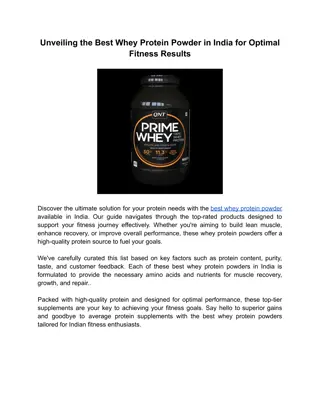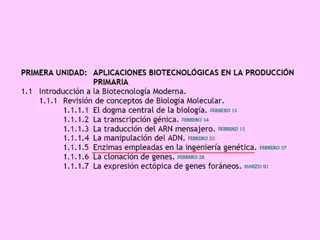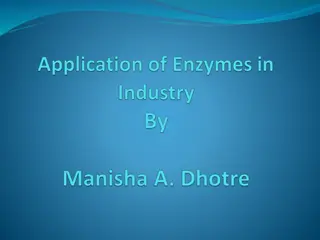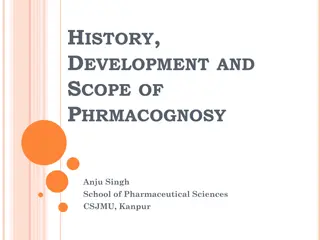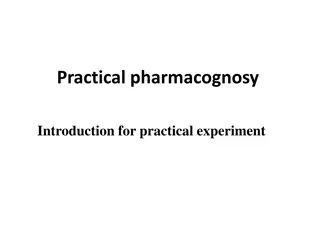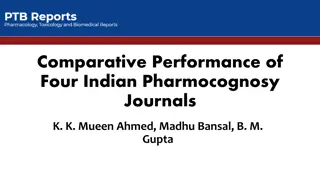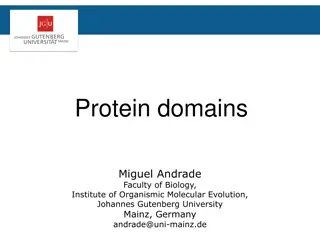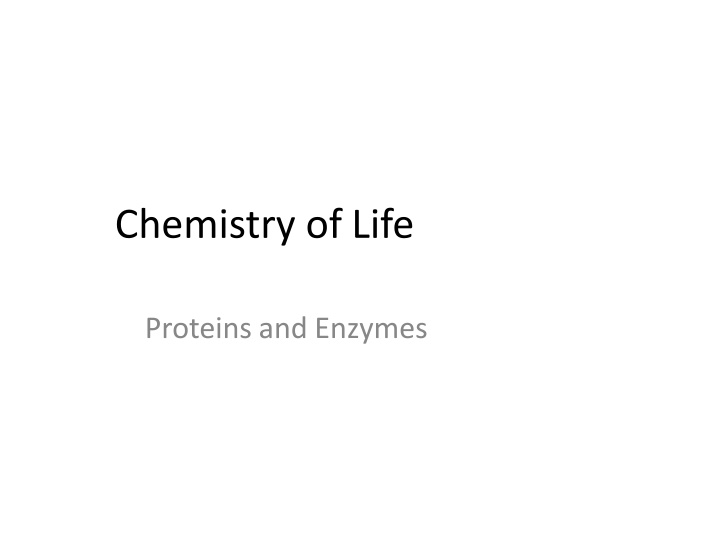
Protein Structure: Primary to Quaternary Levels
Dive into the world of proteins and enzymes by exploring the four levels of protein structure - primary, secondary, tertiary, and quaternary. Understand how amino acid sequences, shapes, bonding, and interactions contribute to the overall conformation of proteins. Be prepared to discuss and potentially ace a quiz on protein structures!
Download Presentation

Please find below an Image/Link to download the presentation.
The content on the website is provided AS IS for your information and personal use only. It may not be sold, licensed, or shared on other websites without obtaining consent from the author. If you encounter any issues during the download, it is possible that the publisher has removed the file from their server.
You are allowed to download the files provided on this website for personal or commercial use, subject to the condition that they are used lawfully. All files are the property of their respective owners.
The content on the website is provided AS IS for your information and personal use only. It may not be sold, licensed, or shared on other websites without obtaining consent from the author.
E N D
Presentation Transcript
Chemistry of Life Proteins and Enzymes
Assignment In the red/black book read the section titled: Four levels of protein structure -primary structure -secondary structure -tertiary structure -quaternary structure Summarize each subtopic Tomorrow you should be able to discuss protein structure. Maybe there will be a pop quiz!!!
#1. Protein Organization A. Proteins have four levels of organization 1. Primary structure = amino acid sequences -these are polypeptide chains (between 50 and 1000 a.a. in length) -20 amino acid names are on p. 69 -changing one of the amino acids in a sequence can change the entireprotein -the R groups of a.a. aid in shaping the protein
A. Proteins have four levels of organization (continued) 1. Secondary structure-describes the shape of the protein -there are two types (alpha helices and beta pleated sheets) -Beta sheets and alpha helices are stabilized by hydrogen bonding between groups in the main chains
A. Proteins have four levels of organization (continued) 3. Tertiary Structure the overall shape of conformation of a polypeptide (the 3-D shape) -caused by bonding of the R groups to each other -hydrophilic R groups bond to each other -hydrophobic R groups bond to each other -types of bonds may include: -covalent -ionic -hydrophobic interactions -hydrogen
A. Proteins have four levels of organization (continued) 3. Tertiary structure continued: -R groups that have sulfur will form covalent bonds with each other (this forms a disulfide bridge)
A. Proteins have four levels of organization (continued) 4. Quaternary structure- association of two or more polypeptide chains to form an entire protein -see p. 75 for a good illustration One protein shown three ways
1. Draw the basic structure of an amino acid and label the groups that are used in peptide bond formation. [4] 2. Outline protein structure.[4]
#2. Protein types (fibrous andglobular) A. Fibrous proteins -have long narrow shape -insoluble in water -Examples 1. collagens-found in connectivetissue -makes up extracellular matrix -found in cartilage, ligaments, tendons, etc. 2.keratins-found in hair, nails and bird feathers
#2. Protein types (fibrous andglobular) B. Globular proteins -have round shape (complex chains folded into complex configurations) -water soluble -Examples: 1. enzymes-catalase 2. hormones-insulin 3. antibodies-immunoglobulins
#3. Polar and Non-polar amino acids A. Polarity of a.a. depends on the R groups B. Polar a.a. have hydrophilic R groups C. Non-polar a.a. have hydrophobic R groups
#3. Polar and Non-polar amino acids D. Polar Amino Acids: -water soluble (remember water is polar/when considering polarity like attracts like ) -In the cell membrane: 1.create channels in the proteins for hydrophobic substances to pass through 2. cause parts of membrane proteins to protrude from the cell membrane 3.Transmembrane proteins have two polar regions (one on surface and one in channel)
#3. Polar and Non-polar amino acids E. Non-polar amino acids -water insoluble -stabilize the entire protein when found in the center of water soluble amino acids -cause proteins to remain embedded in the cell membrane
#5. Specific Protein Examples A. Enzymes (globular) -Amylase: catalyzes the reaction of starch into maltose (first step of chemical digestion) B. Hormones (globular) -Insulin: hormone that reduces blood sugar C. Antibodies (globular) -Immunoglobulins: aid in defenseagainst anitgens D. Hemoglobin (globular) -aids in binding oxygen to red blood cells
#5. Specific Protein Examples E. Collagen (fibrous) -provides structure for skin (without is we get wrinkled) F. Actin and myosin (fibrous) -aids in muscle contractions G. Fibrin (fibrous) -aids in clotting of blood
#6. Enzymes A. Enzymes=globular protein molecules that accelerate specific reactions -enzymes are a type of catalyst -they speed up reactions without changing the products or equilibrium of the reaction -assist in reaching equilibrium faster -catalytic action of enzymes converts substrate to product faster
#6. Enzyme-substrate specificity A. Enzymes are specific to certain reactants B. Reactants=substrate (what you startwith) C. Enzymes have an active site
#6. Enzymes D. Active site=where the substrate binds to the enzyme (the pocket/groove on the enzyme) -not rigid, but it is specific enough to recognize only one substrate -created by the tertiary and quaternary levels of proteinorganization -when substrate enters the active site, it induces the enzyme to slightly change its shape to fit more snugly = induced fit
#7. Lock and key model A. B. Enzymes are substrate specific C. Enzyme specificity is determined by the active site
#8. Induced Fit A. The enzyme has an almost perfect fit to the substrate B. Once the substrate binds to the enzyme the fit becomes tighter
#9. Enzymes and Activation Energy A. If two molecules are going to react with each other they must collide at a certain rate B. The higher the activation energy, the higher the required speed C. Enzymes reduce the required activation energy D. The active site facilitates the chemical change
Graph of activation energy and energy release with and without the presence of an enzyme **This is an exothermic reaction (energy is released)
#10. Temperature and Enzyme Activity A. Increase in temp. can increase activity by increasing the number of collisions between active sites and substrates B. If temp. increases too much, the enzyme will denature C. Most enzyme/substrate interactions have temperature thresholds D. Example: A typical human enzyme has an optimal temperature of 35-40 degrees Celsius -After that the reaction rate sharply decreases
#11. pH and Enzyme Activity A. Very similar to temp. info B. Most enzymes have optimal pH (if the pH deviates to far from optimum the enzyme will denature) C. Example: Pepsin in the stomach is an enzyme that aids in protein digestion -Pepsin works best at pH of 2
#12. Enzyme Denaturation A. When proteins unravel and lose their original conformation B. Can be caused by extreme temperatures or pH levels C. Prevents substrate from binding by changing the active site D. The proteins become inactive
#13. Substrate concentration and enzymes A. Increase in substrate concentration (with fixed enzyme concentration) increases reaction rate B. However, if the substrate concentration increases too much the reaction rate will plateau much quicker -the active sites will be occupied until products are formed -this prevents other substrate molecules from binding
#14. Competitive Inhibition A. Inhibitors-molecules that can reduce the effectiveness of enzymes B. Competitive inhibitors-resemble normal substrate and compete for the active site -prevents intended substrate from binding to the active site -adding more of the substrate may reduce the effects of the inhibitor
#15. Non-competitive Inhibition A. Occurs when an inhibitor binds to the enzyme (but not at the active site) B. By binding to another place on the enzyme, the active site is changed C. Prevents substrate from binding because the shape of the active site has changed D. Adding more substrate will have no effect E. Link
#16. Examples of Inhibitors A. Competitive Inhibition- Example: Prontosil (an antibiotic) -works by inhibiting synthesis of folic acid in bacteria -prontosil binds to the enzyme that aids in producing folic acid and the bacteria dies ** Our cells (animal cells) are not damaged because: -they absorb folic acid from food -they lack the enzyme to produce folic acid -the drug has no effect on animal cells
#16. Examples of Inhibitors B. Non-competitive inhibition Example: Cyanide (CN-) -Cyanide attaches to sulfur groups and destroys disulfide bridges -changes the tertiary structure of the enzymes -the active site becomes changed and cellular respiration is disturbed -energy is not released (no ATP) -if cyanide effects too many cells, the organism dies
#17. Enzymes and Metabolic Pathw A. Reactions occur in specific sequences B. Enzymes catalyze each reaction C. Some build organic compounds and require energy (anabolic pathways) D. Some break down organic compounds and release energy (catabolic pathways)
E. Some metabolic pathways are chain rxns. -Example: glycolysis (chain of ten enzyme controlled reactions that convert glucose into pyruvate) -General reaction: initial substrate intermediate(s) product
F. Some pathways have reactioncycles -substrate is continuouslygenerated -Example: Kreb s cycle
#18. Enzymes and Allostery (96-97) A. Allostery-a type of non-competitive inhibition B. In some metabolic pathways the product of the last reaction inhibits the enzyme that catalyzed the first reaction C. This is end-product inhibition D. Allosteric enzymes=enzymes that are made of two or more polypeptides and can be inhibited by the end product
#18. Enzymes and Allostery E. Allosteric enzymes -have two non-overlapping binding sites (one is the active site, the other is the allosteric site) F. Allosteric site=binding site for the end product -when the end product binds it changes the shape of the active site and prevents substrate binding -the process can be reversed
#19. Advantages of Allostery A. If there is an excess of end-product the entire pathway is switched off B. If there is a decrease in end-product the inhibitor will be removed and normal activity resumes C. Allostery is a type of negative feedback by preventing the over production of end product
#20. Negative feedback A. Negative feedback acts to establish continuous equilibrium -Example: The AC unit in your home has aset temperature -when the temperature gets too far above or below the set temp. the AC unit turns on -when the set temperature is reestablished the AC unit turns off
#21. Allosteric effectors A. Two types 1. allosteric activators-speed reactions up 2. allosteric inhibitors-slow the reactions down B. End products of metabolic pathways can act as allosteric inhibitors C. Example: Phosphofructokinase catalyzes a reaction in glycolysis (end products ATP and pyruvate) -If ATP is already present it will bind to the enzyme to prevent further ATP production
#22. Lactose intolerance A. Lactose intolerance describes the bodies inability to break down lactose in dairy products B. Dairy alternative usually contain the lactose digesting enzyme lactase C. Lactase breaks down 70-100% of the lactose into glucose and galactose D. The nutritional value of the milk remains the same (as if lactase was not present)
#22. The lac operon: controlling gene expression A. Studied in prokaryotes B. Jacob and Monad (1961) -studied synthesis of lactose digesting enzymes in E. coli -found that E. coli do not produce lactose digesting enzymes when grown in a medium without lactose -when E. coli were placed in a lactose rich environment, they produced lactase w/in minutes
#22. The lac operon: controlling gene expression C. If lactase is produced, the gene is on D. If there is no lactose, lactase is not produced and the gene is off
#23. The Operon Model Proposed by Jacob and Monad Explains switching of the genes on and off Operon=promoter, operator and structural genes The lac operon is found in E. coli
(lactose) (lactose)




